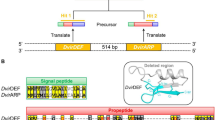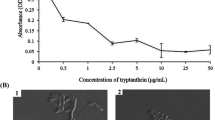Abstract
We constructed recombinant phage particles displaying the Bacillus thuringiensis Cry1Ba4 active toxin using the pfUSE5 and pComb3X phagemid vectors. The recombinant phage particles were screened and evaluated for displayed biologically active Cry1Ba4 toxin against the target insect larvae. Concurrent expression of Cry1Ba4 protoxin was carried out using the pETBlueTM-2 plasmid expression vector in Escherichia coli TunerTM(DE3)pLacI and the protoxin was successfully expressed at a size of 129 kDa. In the bioassay, 3.30 mg crude extract of Cry1Ba4 protoxin, 9.35 × 109 TU and 7.70 × 109 TU of induced recombinant phage particles carrying Cry1Ba4 active toxin displayed on pComb3X and pFUSE5, respectively, demonstrated mortality of greater than 85% against Plutella xylostella (third-instar) within 48 hours. Thus, we have successfully displayed the Cry1Ba4 activated toxin on the surface of a phage and demonstrated toxicity towards larvae.


Similar content being viewed by others
Literature Cited
Hofte H, Whiteley HR (1989) Insecticidal crystal protein of Bacillus thuringiensis. Microbiol Rev 53:242–255
Keller M, Sneh B, Strizhov N, Prudovsky E, et al. (1996) Digestion of delta-endotoxin by gut proteases may explain reduced sensitivity of advanced instar larvae of Spodoptera littoralis to Cry1C. Insect Biochem Mol Biol 26:365–373
de Maagd RA, Bravo A, Crickmore N (2001) How Bacillus thuringiensis has involved specific toxins to colonize the insect world. Trends Genet 4:193–198
Ogiwara KL, Indrasith S, Asano S, Hori H (1992) Processing of δ-endotoxin from Bacillus thuringiensis subsp. kurstaki HD-1 and HD-73 by gut juices of various insect larvae. J Invertebr Pathol 60:121–126
Bradley D, Harkey MA, Kim MK, Biever KD, Bauer LS (1995) The insecticidal Cry1Ba4 crystal protein of Bacillus thuringiensis has dual specificity to coleopteran and lepidopteran larvae. J Invert Pathol 65:162–173
Brizzard BL, Schnepf HE, Kronstard JW (1991) Expression of the Cry1B crystal protein gene of Bacillus thuringiensis. Mol Gen Genet 231:59–64
Tang JD, Shelton AM, van Rie J, De Roeck S, et al (1996) Toxicity of Bacillus thuringiensis spore and crystal protein to resistant diamondback moth (Plutella xylostella). Appl Environ Microbiol 62:564–569
Vilchez S, Jacoby J, Ellar DJ (2004) Display of biologically functional insecticidal toxin on the surface of λ phage. Appl Environ Microbiol 70:6587–6594
Scott JK, Smith GP (1992) Discovering peptide ligands using epitope libraries. Trends Biochem Sci 17:241–245
Su YC, Lim KP, Nathan S (2003) Bacterial expression of the scFv fragment of a recombinant antibody specific for Burkholderia pseudomallei exotoxin. J Biochem Mol Biol 6:25–29
Mahadi NM, Hastowo S, Lay B, Dean DH (1998) Application of multiplex PCR for rapid determination of cry1 gene profiles of new Bacillus thuringiensis isolates. J Microbiol Biotech 8:517–522
Lightwood DJ, Ellar DJ, Jarrett P (2000) Role of proteolysis in determining potency of Bacillus thuringiensis Cry1Ac δ-endotoxin. Appl Environ Microbiol 66:5174–5181
Marzari R, Edomi P, Bhatnager K, Ahmad S, et al. (1997) Phage display of Bacillus thuringiensis Cry1Aa insecticidal toxin. FEBS Lett 411:27–31
Kasman LM, Lukowiak AA, Garczynski SF, McNall RJ, et al. (1998) Phage displayed of a biologically active Bacillus thuringiensis toxin. Appl Environ Microbiol 64:2995–3003
Pacheco S, Gomez I, Sato R, Bravo A, et al. (2006) Functional display of Bacillus thuringiensis Cry1Ac toxin on T7 phage. J Invert Pathol 92:45–49
Monnerat R, Masson L, Brousseau R, Pusztai-Carey M, et al. (1999) Differential activity and activation of Bacillus thuringiensis insecticidal proteins in diamondback moth, Plutella xylostella. Curr Microbiol 39:159–162
Acknowledgments
We thank Mr. Husan Kadir from the Malaysian Agriculture Research and Development Institute for his technical assistance. We acknowledge Prof. George Smith (University of Missouri, USA) for the gift of pfUSE5. We are extremely grateful to Prof. Donald Dean (Ohio State University, USA) and Prof. David Ellar (University of Cambridge, UK) for their critical comments on the manuscript. This project was funded by an IRPA grant (09-02-02-0162) awarded to N.M.M. by the Government of Malaysia. D.H.A.A. was the recipient of a National Science Fellowship awarded by the Ministry of Science, Technology and the Environment, Malaysia.
Author information
Authors and Affiliations
Corresponding author
Rights and permissions
About this article
Cite this article
Nathan, S., Aziz, D.H.A. & Mahadi, N.M. Phage Displayed Bacillus thuringiensis Cry1Ba4 Toxin Is Toxic to Plutella xylostella . Curr Microbiol 53, 412–415 (2006). https://doi.org/10.1007/s00284-006-0164-9
Received:
Accepted:
Published:
Issue Date:
DOI: https://doi.org/10.1007/s00284-006-0164-9




